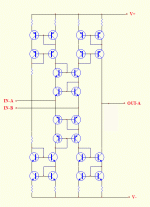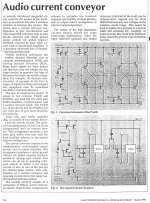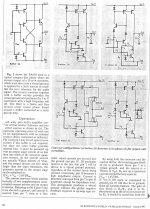I ran across this Current Conveyer Technology and was wondering if someone has heard it in use and if so, any opinions on how well it works.
ACSS

It’s used in the NFB-1 headphone amp by GD Audio.
Lots of TO-92 transistors here:

ACSS
It’s used in the NFB-1 headphone amp by GD Audio.
Lots of TO-92 transistors here:
Attachments
Last edited:
Thanks for that, Minek. It looks like Keantoken and Dadod were the main participants in that thread. I’ll take a look at what they had to say.
It's basically two AD844's back-to-back, without the buffers, CCII current conveyor. If you buy a vintage Wadia D/A converter (or player) chances are there is a CCII as the post D/A current to voltage convertor similar to this, based on a PA630. Wadia called it the swift current conveyor.
Jan
Jan
Attachments
Last edited:
Break it down further, then build from there: the basic architecture is the common-base amplifier.
That is why it has been attractive for I/V uses (and many approaches for this) for a couple of decades - all else is elaboration on the theme. Eventually it becomes called a 'current-conveyor'.
: )
That is why it has been attractive for I/V uses (and many approaches for this) for a couple of decades - all else is elaboration on the theme. Eventually it becomes called a 'current-conveyor'.
: )
xrk971, you ordered GainWire mk3 PCB and never finished it.😕
It uses current conveyor as a gain stage.
https://www.diyaudio.com/forums/sol...-phone-amp-low-distortion-14.html#post4866096
I used this concept in a power amp too: GainWire-NGNFB-classB-PowerAmp
It uses current conveyor as a gain stage.
https://www.diyaudio.com/forums/sol...-phone-amp-low-distortion-14.html#post4866096
I used this concept in a power amp too: GainWire-NGNFB-classB-PowerAmp
Last edited:
Hi Dadod,
Maybe it’s time to pull the partially finished PCB out and populate it then. I did not realize it used this topology. My issue was that once I started assembling it, the sheer number of actives sort of threw me off. Nowadays with more experience under my belt it is not so daunting but I think an SMT implementation on the input and gain stage would be preferable (and faster to assemble).
Regards,
X
Maybe it’s time to pull the partially finished PCB out and populate it then. I did not realize it used this topology. My issue was that once I started assembling it, the sheer number of actives sort of threw me off. Nowadays with more experience under my belt it is not so daunting but I think an SMT implementation on the input and gain stage would be preferable (and faster to assemble).
Regards,
X
Yes X I agree, but that was more than five years ago when I designed it, not many diyers where ready to do SMT, maybe not even now.
Bakoon is a manufacturer which started using current conveyer technology during the late 1980s (AFAIR).
Bakoon HPA-01
Bakoon HPA-01
Did that 10 years ago for my AD1853 DAC.
This is basically sigma-delta DAC with a feedback-free output stage.
First version was based on ad844:
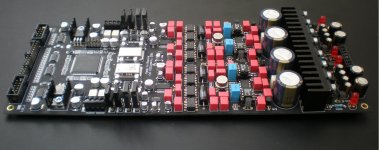
Second on discrete components:
View attachment eclipse_dac_output.pdf
Some resistor values on the schematic are not correct, could not find latest one. Same for photo of the second version, not fully assembled yet here 🙂
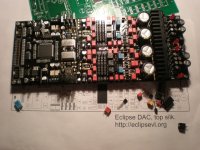
This is basically sigma-delta DAC with a feedback-free output stage.
First version was based on ad844:

Second on discrete components:
View attachment eclipse_dac_output.pdf
Some resistor values on the schematic are not correct, could not find latest one. Same for photo of the second version, not fully assembled yet here 🙂

Pioneer's Super Linear Circuit from 1980 also falls into this category.
The Pioneer Super Linear Circuit
The Pioneer Super Linear Circuit
Did that 10 years ago for my AD1853 DAC.
This is basically sigma-delta DAC with a feedback-free output stage.
First version was based on ad844:
View attachment 928442
Second on discrete components:
View attachment 928439
Some resistor values on the schematic are not correct, could not find latest one. Same for photo of the second version, not fully assembled yet here 🙂
View attachment 928443
That looks quite impressive!
Jan
Would a complex discrete Current Conveyer sound or measure better than a state of the art opamp? My current favorite is OPA1656, getting hard to find due to high demand lately though.
Did that 10 years ago for my AD1853 DAC.
This is basically sigma-delta DAC with a feedback-free output stage.
First version was based on ad844:
View attachment 928442
Second on discrete components:
View attachment 928439
Some resistor values on the schematic are not correct, could not find latest one. Same for photo of the second version, not fully assembled yet here 🙂
View attachment 928443
Beautiful work Eclipsevl! Very nice and neat work.
Would a complex discrete Current Conveyer sound or measure better than a state of the art opamp? My current favorite is OPA1656, getting hard to find due to high demand lately though.
Definitely not measure better. And sound is in the ear of the beholder 😎
Jan
Would a complex discrete Current Conveyer sound or measure better than a state of the art opamp? My current favorite is OPA1656, getting hard to find due to high demand lately though.
When you finish your GW mk3 you can measure and listen it and decide for yourself.
Patrick (EUVL) designed this UTHAiM -- Just for Fun
I have a similar pre and power amp.
A link to some bad photos and half a schematic.
JamJar: an HPA-1-inspired power amp
The THAT 320 & 340 where replaced with BC327/337-40
I have a similar pre and power amp.
A link to some bad photos and half a schematic.
JamJar: an HPA-1-inspired power amp
The THAT 320 & 340 where replaced with BC327/337-40
Thank you jan.didden, xrk971!
The main reason for switching to discrete implementation instead of ad844 is that the output current of ad1853 is too high for ad844 (even in the first version I've used 2 ad844 in parallel for each current output). And since this output stage was based on discrete components (well, except that matched pair transistors were used) and there is no control loop - I had to learn transistor matching technics a few years before I joined the ASIC design community 😀
True. The best result I was able to get is ~-93dB for second harmonic (@1kHz tone).Definitely not measure better. And sound is in the ear of the beholder 😎
Jan
The main reason for switching to discrete implementation instead of ad844 is that the output current of ad1853 is too high for ad844 (even in the first version I've used 2 ad844 in parallel for each current output). And since this output stage was based on discrete components (well, except that matched pair transistors were used) and there is no control loop - I had to learn transistor matching technics a few years before I joined the ASIC design community 😀
- Home
- Amplifiers
- Solid State
- Current Conveyer Technology
